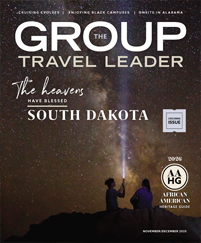It isn’t often a trip to Europe falls into your lap, much less a river cruise in idyllic Northern Italy with a two-day extension to Rome tacked on. But in April of this year, I was invited to join a student performance trip to Northern Italy as a guest of Sandra Weinacht, owner of Inside Europe Travel Experiences. The group comprised the choir from San Marino High School in Los Angeles and their chaperones, friends and family.
This trip marked a lot of firsts for me — first time in Europe, first time on a river cruise, first time on a student performance trip. Thanks to a collection of phenomenal guides, an incredible itinerary and all the Old-World charms of Italy, this trip proved to be a Russian nesting doll of enchanting and educational experiences.
Here are seven lessons I learned along the way.
1. Transatlantic Flight: Travel to Europe is less complicated if you’re prepared
As someone who seldom manages to sleep on planes, I wasn’t overly excited for the roughly 10-hour flight to Venice. But when I stepped off the plane at 10 a.m. local time, my first thought was, “that wasn’t so bad.”
A big part of the ease I felt was due to being so prepared. I already knew to prepare for the obvious things, like making sure my passport was up to date. But I’d also been advised to exchange currency at my local bank rather than scrambling to do it upon arrival, and I had borrowed a power adapter and downloaded the Customs and Border Patrol Mobile Passport Control (MPC) app to make re-entry to the country easier.
Tour operators can expect many of their travelers to feel a bit of anxiety, particularly if they’re young or inexperienced with international travel. Nothing makes you nervous like waiting in line with your passport to meet the stern face of a customs officer for the first time. But all the preparations I made significantly eased my nerves and let me sit back and enjoy my first overnight flight to Europe, including the stunning view as we flew over the Alps on the way to the Venice Marco Polo Airport.
2. Mantua: Lesser-known destinations are worth exploring
I met Weinacht and her team at the airport, and we began our drive to Mantua, the starting point of the six-day river cruise. I had never heard of Mantua before, but what I found there couldn’t have given me a more favorable first impression of Italy.
This ancient city in Lombardy is a UNESCO World Heritage Site. A guided tour took us to see some of its significant cultural hot spots, including the Palazzo Ducale, the palace built and occupied by the powerful Gonzaga family, who ruled from 1328 to 1707 and transformed the city into a hub of culture and art.
We learned about the Torre dell’Orologio, a 15th-century Renaissance clock tower that also observed moon phases and zodiac signs. We also visited the Basilica di Sant’ Andrea, commissioned by the Gonzagas in 1472. In addition to its high arched ceilings, Roman façade and frescoed interior, the basilica is notable for housing a holy relic — sand said to contain drops of Christ’s blood collected during the crucifixion.
Explorations on our own yielded just as many wonders as our tour. The town’s cobblestone piazzas were bustling, but not overcrowded, and lined with shops that beckoned us inside with displays of colorful candies, fresh-baked breads and handmade pastas. Gelaterias were authentic and easy to find.
The choir’s first performance was held in the Romanesque Rotonda di San Lorenzo, an 11th-century church modeled after Jerusalem’s Church of the Holy Sepulchre. It was awe-inspiring to stand in a structure built over a millennium ago, and the music sounded gorgeous in the intimate setting.
Mantua is a gem travelers could easily pass over for more prominent Italian cities, but to do so would be a huge mistake. In Mantua, travelers can appreciate authentic regional flavors, rich history and jaw-dropping architecture while dispensing with overwhelming crowds and inflated prices.
3. Verona: Visit the hot spots, but look for hidden gems
If anyone can remember their high school English classes, they may recall the opening monologue from Shakespeare’s “Romeo and Juliet,” which sets its scene in “fair Verona.” Sadly, that was the extent of my familiarity with the city.
When in Verona, most tourists want to visit Juliet’s House, which features a small stone courtyard with a statue of Juliet beneath a stone balcony. Visitors can go out onto the balcony and recite Juliet’s lines, but they may not know it’s actually a 20th-century addition to a local building with no meaningful connection to the Shakespeare play.
Though the balcony itself was a tourist trap, I was charmed by the thousands of love locks chained to the fence leading into the little courtyard, relics of a thousand couples pledging their devotion.
However, there were a dozen other surprises in Verona that made the visit worthwhile, including the Verona Arena, a Roman amphitheater dating back to 30 A.D., and even a 14th-century castle, Castelvecchio, overlooking the Adige River.
Another one of these surprises came before we even arrived in Verona, when Weinacht took a small group of us to find an authentic Italian bite to eat. We found a charming restaurant in the countryside, Trattoria Le Donne Di Alfeo. The owners served us their homemade pasta stuffed with squash and cheese, along with immensely flavorful grilled vegetables. They even treated us to their homemade hazelnut liqueur.
Our visit to Verona taught me to visit the tourist hot spots but also never to stop looking for hidden gems; these might be where you make some of the most worthwhile memories.
4. San Marino: Personalized itineraries elevate a trip
The group got an early start the next day and was bussed to San Marino, a landlocked microstate in central Italy. It’s the third smallest state in Europe and fifth smallest in the world. And, because they were so close, the San Marino High School choir wanted to visit their school’s namesake.
The bus ride to the city’s historic district boasted dramatic mountain vistas. At the top, the city’s steeply sloping streets gave way to large piazzas with historic bell towers and amazing views of the verdant slopes and red rooftops below. Eclectic museums, shops and restaurants lined the streets. Looming over it all, magnificent stone castles with even more incredible views were available for tours. A local guide gave us an extensive tour of the city’s rich history, including the history of Saint Marinus and the republic’s complicated relationship with the Catholic church.
The students performed in the Basilica San Marinus, with another added surprise: Students from a local high school were in the audience. Following the performance, the students from both schools got a chance to meet each other and spend time together.
The day trip to San Marino was not part of Weinacht’s standard Northern Italy itinerary, but it was a bonus stop that added a level of richness to the students’ experience on both sides. Flexibility and personalization within an itinerary can add layers to the trip, perhaps not only for travelers, but also for the places they travel to.
5. Burano: Stray from the beaten path
Renowned for its colorful buildings and lace-making traditions, Burano was a gorgeous sight to take in from my cabin as we docked the following morning.
We set out to explore while it was still early. I was amazed by the vivacity of the colors on the island, from the facades of its homes to the boats that lined its canals.
In Burano, I learned the importance of straying from the beaten path when exploring a new place. There were main avenues designed for tourists with shops on either side, but some of the most breathtaking sights were found in alleyways and hidden courtyards. That’s where we saw buildings painted purple to match the blooming wisteria that coated their facades and tables being set for restaurants with glassware that sparkled like gemstones. We saw ordinary people beginning the day in their boats, hanging laundry out to dry on clotheslines, paving the streets and preparing food for their restaurants.
That’s not to say we shunned the traditional tourist experience — we still shopped for spices, glassware and clothing before heading back to the ship. But the magic of Burano’s colorful streets felt far greater the farther we strayed from the beaten path.
6. Venice: River cruising unlocks a lot of potential
After our morning outing in Burano, we enjoyed lunch while en route to the heart of Venice, where we would dock for the remainder of the trip.
There was a lot about river cruising that was pleasantly surprising. The chartered ship, MS Michelangelo, was specifically designed to be smaller and more compact to navigate the waterways of Italy. The ship’s 78 cabins were small but sensible, and the crew provided excellent service. Chartering the boat also meant the students enjoyed the run of the ship, including late-night karaoke parties that wouldn’t have been possible in a hotel.
We’d already gone through locks outside of Mantua, something fascinating to see up close, but I’ll never forget sailing into Venice. We glided along the teal waters of the Venetian Lagoon, passing centuries-old buildings with intricacies that demonstrated the convergence of the city’s Byzantine, Gothic and Renaissance architecture. Gondolas drifted lazily down canals, and shops, cafes and markets lined the streets. Each alley led to a surprise, such as the Palazzo Contarini del Bovolo, known for a 15th-century, multi-arch spiral staircase straight out of a fairytale, where the students performed.
This trip taught me that river cruising is an ideal way to explore Italy, and that became especially apparent in Venice. The group didn’t have to stay at a hotel near the airport because we were docked just a 10-minute walk from St. Mark’s Square. The group especially enjoyed being set loose in the heart of one of the world’s most magnificent cities, all without ever having to change hotel rooms.
7. Rome: Student travel is so much bigger than I knew
I wanted to see a little more of Italy before I left, so I took an early morning train from Venice to Rome to meet up with another one of Weinacht’s student groups.
After a private rehearsal in one of the chapels in Vatican City, the students headed into St. Peter’s Basilica to sing at the evening mass. Completed in 1626, this marvelous basilica was designed by some of history’s most famous architects, from Bramante to Raphael. The 452-foot-tall dome overhead, painted with images of the apostles, was designed by Michelangelo. Opulent details like St. Peter’s Chair, a gilded throne by the altar, and the Baldacchino, which marks the grave of Saint Peter, add to its splendor.
The group’s performance was as lovely as their rehearsals foreshadowed, but what struck me most occurred when mass was over. Small groups of students embraced with tears streaming down their cheeks. Whether they were moved by their faith or simply overwhelmed by the undeniable gravity of performing in the Vatican, this display of emotion was proof of how profoundly affected they were by this travel experience.
Thinking of my own student trips invokes memories of a neon-lit Times Square and staying up all night with my friends. But I didn’t realize how my own travels as a student may have shaped me until I saw other lives being shaped in the same way. Watching them enjoy the opportunity to experience a city that’s been the lifeblood of civilization for thousands of years showed me the world of student travel has fewer limits than I thought.
The next day, the group visited iconic Roman sites like the Colosseum, the Pantheon and Trevi Fountain. As we explored the beautiful Piazza Navona, I thought about how this life-changing trip to Italy might affect this group. Perhaps they would become avid travelers, curious about the world for the remainder of their lives. Or maybe they would simply carry the memories of eating gelato in the heart of Rome, surrounded by their friends.
Either way, I felt lucky to bear witness.











